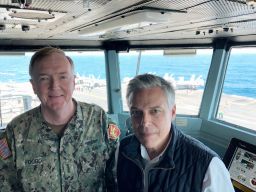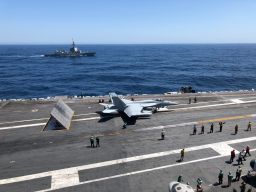With Russia increasingly deploying forces on NATO’s doorstep, the United States has started its own show of force in the Mediterranean Sea.
For the first time since 2016, the United States is deploying two Nimitz-class aircraft carriers, the USS John C. Stennis and the USS Abraham Lincoln, showing Moscow that the United States will not in any way back down in this important geopolitical area.
“We’re not going to be deterred by any potential adversary and we are going to support our interests as Americans and also those of our allies as we steam throughout the world,” said Adm. James Foggo, the commander of US Naval Forces in Europe and Africa, standing on the bridge of the Abraham Lincoln.
CNN was given exclusive access to the carrier operations, which serve to improve coordination between two carrier strike groups that consist of several ships and up to 120 aircraft each.
A typical carrier strike group includes an aircraft carrier, a guided-missile cruiser, two guided-missile destroyers, an attack submarine and a supply ship for logistical support.
That coordination is extremely important as US military dominance in the world is being increasingly challenged by resurgent powers like Russia and China, said Rear Adm. John Wade, the commander of Carrier Strike Group 12, which includes the USS Abraham Lincoln. “Our senior leadership has mandated that our Navy become more lethal and more tactically proficient. It’s very important in the era of competition that we are in.”

The fact that Russia is one of the main recipients of the US power play in the Mediterranean was driven home as Jon Huntsman, the US ambassador to Russia, came aboard the carrier strike group.
Huntsman essentially called the aircraft carriers floating American diplomacy.
“When you have 200,000 tons of diplomacy that is cruising in the Mediterranean – this is what I call diplomacy, this is forward operating diplomacy – nothing else needs to be said,” he said. “You have all the confidence you need to sit down and try to find solutions to the problems that have divided us now for many, many years.”
Russia is increasingly deploying its forces in many of the places where it has diplomatic conflicts with the United States. In Syria, Moscow maintains a large military presence and is close to signing a long-term lease for the port of Tartous, where its naval forces are already based.

In the Black Sea, the Russian Navy has significantly upgraded the port of Sevastopol in annexed Crimea, and has deployed new ships and upgraded submarines there. The United States and its allies say Russia is becoming more bold and beefing up its presence in the Atlantic and Arctic.
President Trump has repeatedly called into question America’s commitments to its NATO allies, lamenting that many European nations don’t meet their spending commitments of 2% of GDP for defense. But Huntsman said the massive armada now deployed in the Mediterranean shows America remains as committed as ever.
“This is a focus on our NATO colleagues and ensuring that we have the proper messages of reassurance, of collaboration, of a commitment to the region,” he said. “One that has been very troubled because of some of Russia’s actions. And we’re not leaving and NATO is still the strongest collective security organization in history and we’re a big part of it.”





